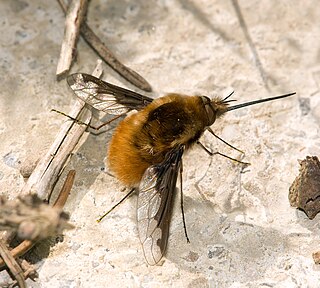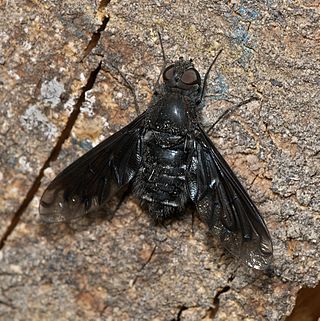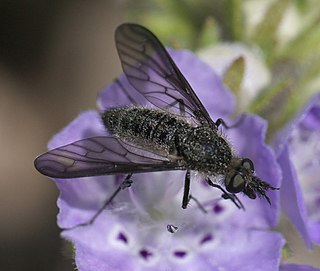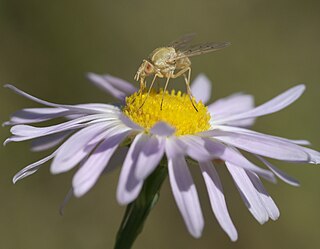
The Bombyliidae are a family of flies, commonly known as bee flies. Some are colloquially known as bomber flies. Adults generally feed on nectar and pollen, some being important pollinators. Larvae are mostly parasitoids of other insects.

Anthrax is a genus of bombyliid flies, commonly known as "bee-flies" due to their resemblance to bees. Most are dull black flies, and are usually small to medium in size, 4–20 millimetres (0.2–0.8 in), and many species have striking wing patterns.

Villa is a genus of flies belonging to the bee-fly family (Bombyliidae). They range in size from 5 to 17 millimetres, and have typically rounded heads. The males of some species have a brilliant mat of silvery patagial scales. About 270 Villa species are found on all continents except Antarctica. They can be distinguished from similar genera (Hemipenthes) by their wing venation.

Conophorini is a tribe of bee flies in the family Bombyliidae.

Bombyliinae is a subfamily of bee flies in the family Bombyliidae. There are more than 70 genera in Bombyliinae.

Lordotus is a genus of bee flies. There are at least 30 described species in Lordotus.

Poecilognathus is a genus of bee flies. There are at least 20 described species in Poecilognathus.

Chrysanthrax is a genus of bee flies in the family Bombyliidae.

Chrysanthrax dispar is a species of bee fly in the family Bombyliidae.
Chrysanthrax eudorus is a species of bee fly in the family Bombyliidae.
Tmemophlebia is a genus of bee flies in the family Bombyliidae. There are about 16 described species in Tmemophlebia.
Chrysanthrax vanus is a species of bee fly in the family Bombyliidae.
Chrysanthrax adumbrata is a species of bee fly in the family Bombyliidae.
Chrysanthrax anna is a species of bee fly in the family Bombyliidae.
Chrysanthrax arizonensis is a species of bee fly in the family Bombyliidae.
Chrysanthrax atratus is a species of bee fly in the family Bombyliidae.
Chrysanthrax scitulus is a species of bee fly in the family Bombyliidae.
Chrysanthrax turbatus is a species of bee fly in the family Bombyliidae.

Lordotinae is a small subfamily of bee flies in the family Bombyliidae. This subfamily was formerly considered a tribe of Bombyliinae, but was elevated to subfamily as a result of research published in 2019.

Neacreotrichus is a genus of bee flies in the family Bombyliidae. There are about 13 described species in Neacreotrichus, found in the United States and Mexico.











